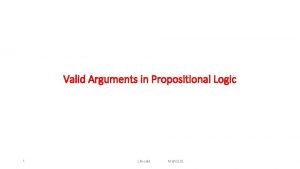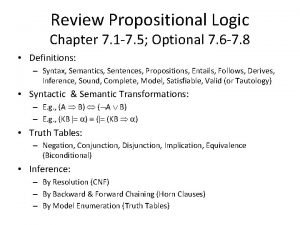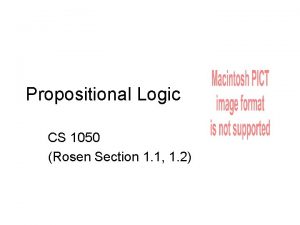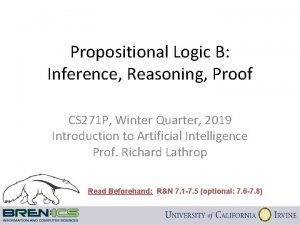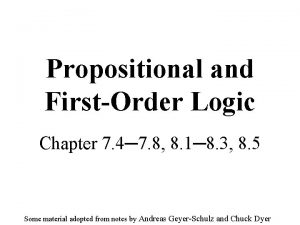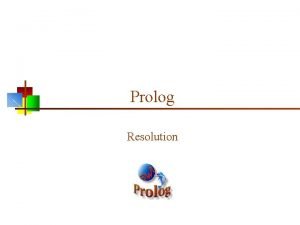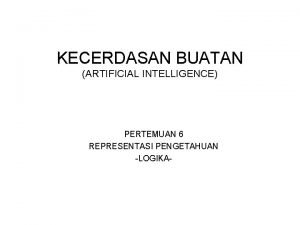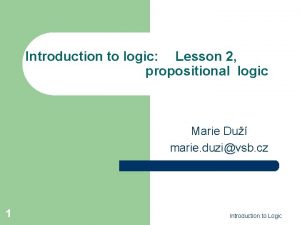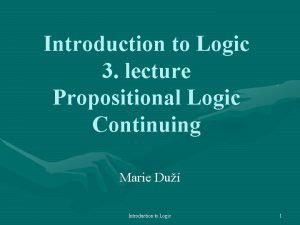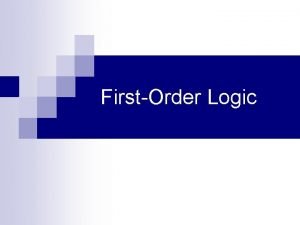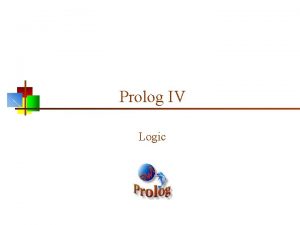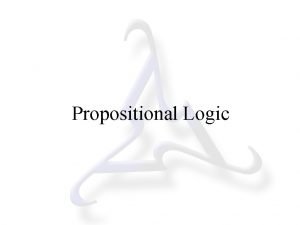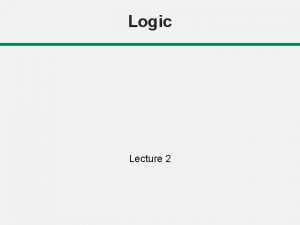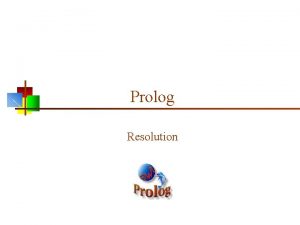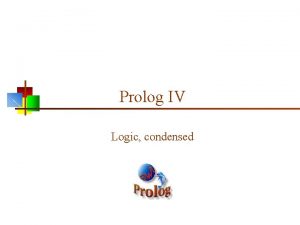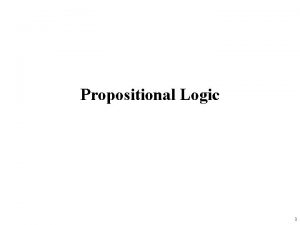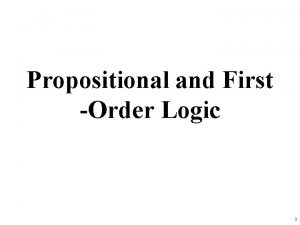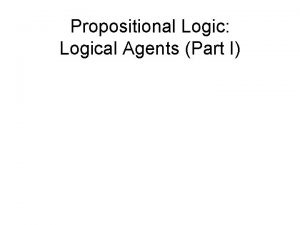Unit 1 Lecture 5 Propositional Logic Proposition A













- Slides: 13

Unit 1 Lecture 5 Propositional Logic

Proposition A proposition is a declarative sentence that is either true or false. Examples of propositions: • The Moon is made of green cheese. • Trenton is the capital of New Jersey. • Toronto is the capital of Canada. • 1+0=1 • 0+0=2 • Examples that are not propositions • Sit down! • What time is it? • x+1=2 • x+y=z

Propositional Logic Constructing Propositions • Propositional Variables: p, q, r, s, . . . • The proposition that is always true is denoted by T and the proposition that is always false is denoted by F. • Compound Propositions; constructed from logical connectives and other propositions • Negation ¬ • Conjunction ∧ • Disjunction ∨ • Implication → • Biconditional ↔

Disjunction • The disjunction of propositions p and q is denoted by p ∨ q and has this truth table: p q p ∨q T T F F F

Conjunction • The disjunction of propositions p and q is denoted by p ∧ q and has this truth table: p q p∧q T T F F F T F F

Implication • If p and q are propositions, then p → q is a conditional statement or implication which is read as “if p, then q” and has this truth table: p q p →q T T F F F T T F F T • In p → q, p is the hypothesis (antecedent or premise) and q is the conclusion (or consequence). • Implication can be expressed by disjunction and negation: p → q ≡ ¬p ∨ q

Understanding Implication • In p → q there does not need to be any connection between the antecedent or the consequent. The meaning depends only on the truth values of p and q. • This implication is perfectly fine, but would not be used in ordinary English. “If the moon is made of green cheese, then I have more money than Bill Gates. ” • One way to view the logical conditional is to think of an obligation or contract. “If I am elected, then I will lower taxes. ” • Different Ways of Expressing p → q : if p, then q p implies q if p, q p only if q q unless ¬p q when p q if p q whenever p p is sufficient for q q follows from p q is necessary for p a necessary condition for p is q a sufficient condition for q is p

Converse, Contrapositive, and Inverse q → p is the converse of p → q ¬q → ¬p is the contrapositive of p → q ¬p → ¬q is the inverse of p → q Example: Find the converse, inverse, and contrapositive of “It is raining is a sufficient condition for my not going to town. ” Solution: • converse: If I do not go to town, then it is raining. • inverse: If it is not raining, then I will go to town. • contrapositive: If I go to town, then it is not raining • • •

Biconditional • If p and q are propositions, then the biconditional proposition p ↔ q has this truth table p q p ↔q T T F F F T p ↔ q also reads as p if and only if q p iff q. p is necessary and sufficient for q if p then q, and conversely p implies q, and vice-versa

Precedence of Logical Operators • ¬ • ∧ • ∨ • → • ↔ Thus p ∨ q → ¬r is equivalent to (p ∨ q) → ¬r. If the intended meaning is p ∨ (q → ¬r) then parentheses must be used.

Satisfiability, Tautology, Contradiction • A proposition is • satisfiable, if its truth table contains true at least once. Example: p ∧ q. • a tautology, if it is always true. Example: p ∨ ¬p. • a contradiction, if it always false. Example: p ∧ ¬p. • a contingency, if it is neither a tautology nor a contradiction. Example: p.

Logical Equivalence • Two compound propositions p and q are logically equivalent if the columns in a truth table giving their truth values agree. This is written as p ≡ q. • It is easy to show: • Fact p ≡ q if and only if p ↔ q is a tautology. • De Morgan’s Laws: ¬(p ∧ q) ≡ ¬p ∨ ¬q ¬(p ∨ q) ≡ ¬p ∧ ¬q Truth table proving De Morgan’s second law.

De Morgan’s Laws pq ¬p ¬q (p∨q) ¬p∧¬q T T T F F F T T F T T Important Logical Equivalences Domination laws: p _ T T, p ^ F = F Identity laws: p ^ T p, p _ F = p
 First order logic vs propositional logic
First order logic vs propositional logic First order logic vs propositional logic
First order logic vs propositional logic First order logic vs propositional logic
First order logic vs propositional logic Propositional logic
Propositional logic Propositional logic examples
Propositional logic examples Xor in propositional logic
Xor in propositional logic Xor in propositional logic
Xor in propositional logic Propositional logic notation
Propositional logic notation Implies in propositional logic
Implies in propositional logic Propositional logic
Propositional logic Propotional logic dapat digunakan untuk
Propotional logic dapat digunakan untuk Tense logic
Tense logic Contradiction formula
Contradiction formula Pros and cons of propositional logic
Pros and cons of propositional logic



